How To Make A Hanging Mobile
How to Build / Brand Mobiles / Kinetic Sculptures
I'm a kinetic sculptor specializing in mobiles. I've received e-mails over the years asking to know how to brand mobiles, which eventually prompted me to put together this page. It explains the basics about the balance structure that a mobile is made of, which is essentially a whippletree mechanism. It's all about physics, which may seem complicated at commencement, but information technology's actually actually quite elementary if you build the construction from the lesser to the top of the mobiles, just like Alexander Calder (who invented the art course of mobiles in the early 1930s) did. Wait through the post-obit four illustrations, so read the rest below.
Part A weighs the same as part B – Balance bespeak is correct in the middle:
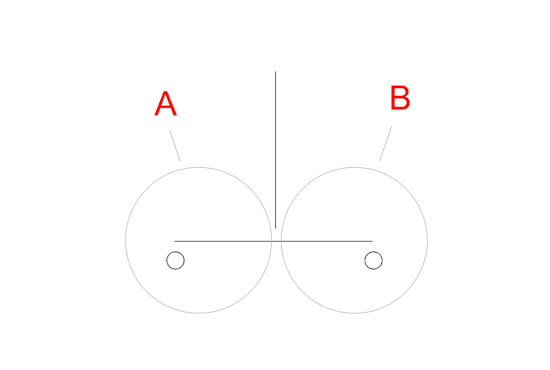
Part A weighs more than part B – Remainder betoken moves closer to part A, the heavier part:
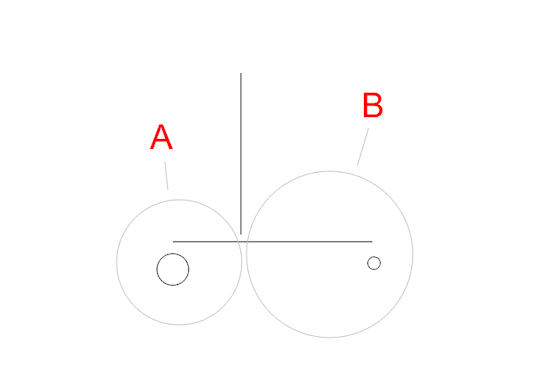
The post-obit illustration might expect more complex, but it's really the verbal same idea. All those lower parts marked every bit "B" count equally just one part when it comes to the balance of the top part, it'due south still only about the residue betwixt part A and part B:
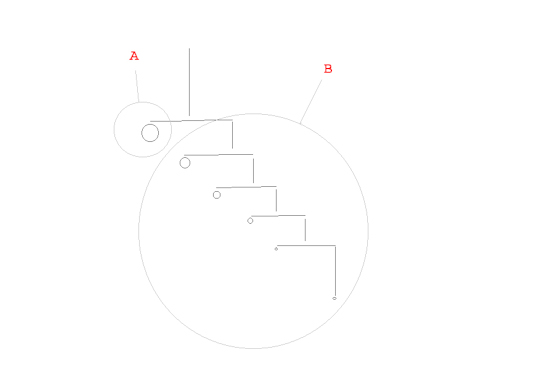
And then it merely goes on like that to the next level of the mobile:
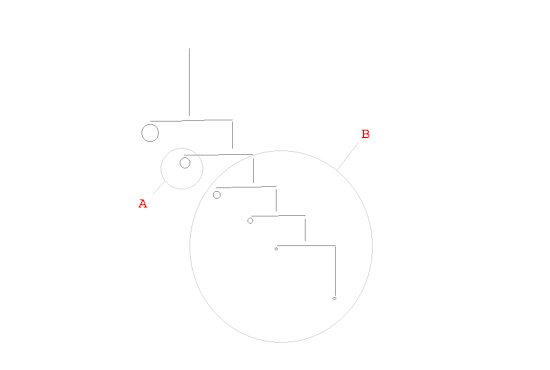
The trick is that y'all build the mobile from bottom to top. Start with connecting the kickoff 2 elements at the bottom of the mobile and observe the balance point between them. Then you connect the next upper chemical element to that residuum point, and again, find the balance point betwixt the new chemical element and the first two elements and so on. You tin can find the rest point by holding the connecting arm with your fingers and moving information technology back and along, or if yous want to exist exact, tie a cord around the connecting arm and move it dorsum and forth until it balances.
In Alexander Calder'south own words: "I brainstorm with the smallest and piece of work up. Once I know the remainder point for this first pair of discs, I anchor it by a claw to another arm, where information technology acts equally one stop of some other pair of scales, and then on up. It'due south a kind of ascending scale of weights and counterweights." – from Curtis Cate, Calder Made Easy, Horizon Magazine, vol. 9, no. 1 (Winter 1972).
I would also recommend to take a look at a how-to article I wrote for Houzz: From the Artist: How to Make a Existent Mobile
One time you understand the basics on how to build this balance structure, anything goes from in that location. You tin can use whatever you like for the weights at the terminate of the arms, and you can play effectually with how you build the structure, make some artillery longer than others, make some of them point in a more vertical direction than others, and and then on. The possibilities are infinite.
Oh, here's something else to consider:
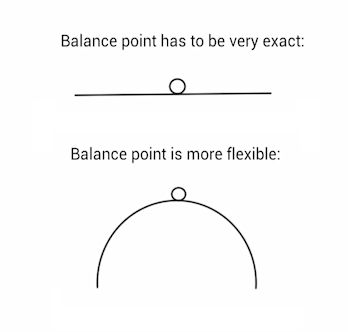
There'due south no need to understand this beyond what the above illustration shows, but if yous're interested in physics: there's a residuum bespeak and a heart of the mass (weight) for an object. If the eye of mass of the object is above the balance point (meaning the majority of the weight is higher up the residual signal), the object will fall over. If the eye of mass of the object is below the balance point, it volition balance. The farther below the residue point the center of mass is, the more than stable is the balance. So past making the parts of a mobile curved downwards, yous lower the heart of mass, and therefore making it more stable and easier to rest. Also see my blog mail Remainder – Suspension Points and the Centers of Mass in Abstract Mobile Sculptures and there's as well a Wikipedia page nigh the middle of mass that explains more about this.
Y'all can also use "sliders" to build flexibility into your mobile designs. Using sliders to adjust the balance points on a mobile allows for easy experimentation with design options and reduces the chance of wasted materials. Also take a look at the micro-adjustment sliders that Jay Jones developed for his line of "Build it Yourself" Mobile Kits. He tested over 30 materials and configurations before arriving at the one used. The kits are also available at MoMA NYC, MoMA SF, Guggenheim NYC and the Smithsonian among other museum shops. It appears that Jay Jones has stopped making them in 2020 or 2021, and so they may be sold out in some shops at present.
Additional resources for making mobiles:
- Web log mail service I wrote about What Wire to Apply to Make a Hanging Mobile and Where to Buy It
- Blog mail with mobile-making related questions that I've received via electronic mail and my answers
- An article I wrote for MAKE magazine on How to Make a Mobile Based on Calder's Mobiles
- An article I wrote for Houzz: From the Creative person: How to Make a Real Mobile – It'south All in the Balancing Points (there's a number of questions and answers in the annotate section of the article as well). The article is at present also available in German
- A history of early mobiles that I've put together
- Some technical ("behind-the-scenes") aspects of designing, making and installing a big custom mobile
- A definition of mobiles
- Q&A most Mobiles for a center school student's math form project
- See some of my mobiles if y'all're looking for pattern ideas: handmade mobiles, large custom-made mobiles, 3D printed mobiles and kinetic sculptures
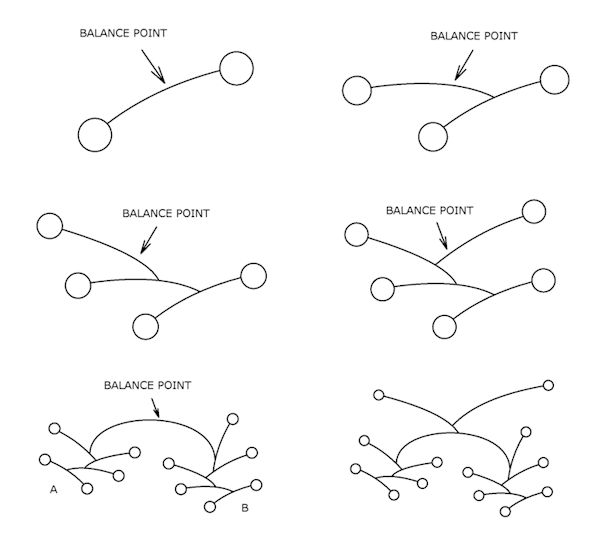
If there'southward anything else I tin can assistance with, don't hesitate to contact me.
And just for fun, here's some other quote by Alexander Calder when he was asked how he gets that subtle balance in his work: "You put a disk hither and so you put another deejay that is a triangle at the other finish so you balance them on your finger and go on on adding. I don't use rectangles––they terminate. You tin can use them; I have at times merely simply when I want to block, to constipate movement."
A diagram by Alexander Calder on how to install one of his mobiles at the IMA in 1947:
Source: https://www.marcomahler.com/how-to-make-mobiles/

0 Response to "How To Make A Hanging Mobile"
Post a Comment